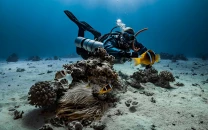US scientists attempting to harvest human organs in pigs
Scientists have successfully created part-human, part-pig embryos by combining human stem cells and pig DNA

This pregnant sow is carrying human-pig chimera embryos PHOTO: BBC
Scientists have now successfully created part-human, part-pig embryos by combining human stem cells and pig DNA. The embryos were allowed to mature for 28 days, after which the experiment was terminated and the tissue analysed.
Researchers believe the animals, if they had been carried to term would have developed a human internal organ, but would have looked and behaved like any other pig. The aim behind the experiment is that in future, animals would be able to provide organs for life-saving transplants.
Spare organs: Illegal organ transplant market thrives in Pakistan
To create the “chimeric” embryos, the scientists used a gene-editing technique known as Crispr to knock out a section of the pig’s DNA necessary for the embryo to develop a pancreas.
“You are basically creating a vacuum, a hole, so that the human cells respond to the right cues, they make a pancreas. The pig cells can’t. But what we don’t know, and this is what they need to look at, is whether the human cells can also contribute substantially to other tissues, and particularly they are worried about the brain,” said Robin Lovell-Badge, a geneticist at the Francis Crick Institute in London.
However, the experiment has seen opposition from US authorities. In September last year, the US National Institutes of Health said it would not back research into “chimeras” until it knew more about the implications.
It cited fears that the presence of human cells could affect the animal’s brain and behaviour, potentially making it more human. However, Prof Pablo Ross, the reproductive biologist leading the research, has tried to calm these fears, saying there was a “very low potential for a human brain to grow”.
“Our hope is that this pig embryo will develop normally but the pancreas will be made almost exclusively out of human cells and could be compatible with a patient for transplantation,” he said.
Scientists unveil plan to create synthetic human genomes
Lovell-Badge, on the other hand, holds that the experiment has a lot of potential problems. One of them is that there are other cell types which are going to be present in the organs which come from the pig. “Those would be a big problem and they would be rejected by a human,” he said.
Concerns have also been raised that the transplantation of an organ from an animal into a human could risk introducing animal viruses into a patient.
This is not the first time scientists have attempted to create chimeras. Among the previous experiments, scientists using different techniques were able to produce a mouse with a rat’s pancreas, and mice with livers almost completely composed of human cells.
“The whole idea of making chimeras, mixing different animal species or human-animal, has been around for decades,” said Lovell-Badge.
This article originally appeared on Guardian.



















COMMENTS
Comments are moderated and generally will be posted if they are on-topic and not abusive.
For more information, please see our Comments FAQ